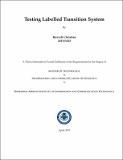Please use this identifier to cite or link to this item:
http://drsr.daiict.ac.in//handle/123456789/676| Title: | Testing Labelled Transition System |
| Authors: | Bhateja, Puneet Christian, Ruzvelt |
| Keywords: | Isomorphic Algorithms Synchronous Sysem |
| Issue Date: | 2017 |
| Publisher: | Dhirubhai Ambani Institute of Information and Communication Technology |
| Citation: | Ruzvelt Christian(2017).Testing Labelled Transition System.Dhirubhai Ambani Institute of Information and Communication Technology.viii, 31(Acc.No: T00638) |
| Abstract: | "For a successful interaction among computer systems from distinct manufactures, standardize communication protocol are being generated and specified. Implementation of those protocol are required that conforms to those specification. Testing is a process of checking the accuracy of protocol implementation with respect to their specifications. This is called as the protocol conformance testing. In this thesis we will study the formal approach to protocol conformance testing. The final aim of the thesis is to derive approach for the derivation of useful test sets from formal specifications. The test cases that we have derived should not detect any kind of errors. In addition to it, the test cases that we have derived should be meaningful. Starting to this point chapter 1 gives the introduction of the thesis. The idea of testing are being introduced in chapter 1. Also the difference between testing and verification is being introduced. Chapter 2 introduce labelled transition systems in detail. The detail definition and representation have been introduced in this chapter. In chapter 3 relations are proposed using the standard of observation: the behavior of an implementation is true if all observations made of the implementation by an environment, can be explained from the behavior of the specification. In chapter 4, for a particular relation conf, test generation algorithms are developed. These algorithms are used to derive tests from an LTS specification, which should be complete and correct. An implementation relation that we have discussed in chapter 3 and the test derivation algorithm id chapter 4 assume that the tester and the implementation communicate with each other via synchronous communication. Chapter 5 shows that if the implementation and tester interact via a FIFO buffer than it is not applicable. To demonstrate this a queue operator is define to create asynchronous communication among the tester and the implementation. The queue operator consist two queues, one is an input queue and the othe one is an output queue. Any system that interact asynchronously with its environment is called a queue context. Finally, chapter 6 conclude this thesis. By adding the input queue and outputqueue we have converted behaviour of asynchronous system into synchronous system." |
| URI: | http://drsr.daiict.ac.in//handle/123456789/676 |
| Appears in Collections: | M Tech Dissertations |
Files in This Item:
| File | Description | Size | Format | |
|---|---|---|---|---|
| 201511025.pdf Restricted Access | 201511025 | 935.29 kB | Adobe PDF |  View/Open Request a copy |
Items in DSpace are protected by copyright, with all rights reserved, unless otherwise indicated.
